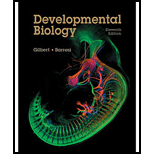
Concept explainers
To review:
The control of diseases such as malaria by altering insect metamorphosis.
Introduction:
Malaria is one of the most widespread vector-borne diseases common in tropical and subtropical areas of the world, including regions in Africa, Asia, and America. Malaria is caused by the protozoan
Explanation of Solution
Hormonal control is essential for coordination and regulation of many aspects of the developmental process in many organisms. Insect molting and metamorphosis are controlled by two effector hormones: the steroid 20-hydroxyecdysone (20E) and the lipid juvenile hormone (JH). 20E has been characterized as the principal molting hormone in insects (Gilbert et al., 2002), which initiates and coordinates each molt (larva-to-larva, larva-to-pupa, pupa-to-adult) and regulates the gene expression changes that occur during metamorphosis. Molting and metamorphosis are initiated by a rise in the titer of the ecdysteroids. Upon initiation of the endocrine signaling, 20E binds to the ecdysone receptor (EcR), a member of the nuclear hormone receptor superfamily, which heterodimerizes with another nuclear receptor. The regulation of insect metamorphosis is controlled by the juvenile hormone (JH), ecdysone, and active hormone 20E. 20E and JH together cause molts forming next larval instar. The low concentration of JH, the 20E-induced molt produces pupa instead of larva. When 20E acts in the absence of JH, the imaginal discs differentiate and the molt gives rise to an adult (imago).
In Lepidoptera, there is one or more small peaks of ecdysteroids in the absence of JH following attainment of a critical weight that initiate metamorphic events such as wandering behavior. Then a high peak of ecdysteroids in the presence of JH initiates pupation. In numerous studies, precise fluctuations of ecdysteroid titers in last instar larval and in pupal stages of Ae. Aegypti have been determined. Many studies attempted to correlate ecdysteroid levels to gene expression profiles to measure ecdysteroid fluctuations in our system. Expression of ecdysone receptors, transcription factors and other ecdysone-regulated genes was compared with the timing of ecdysteroid peaks.
The future research focuses on the specific function(s) of ecdysone receptors and ecdysone regulated transcription factors during mosquito development to control malaria.
Want to see more full solutions like this?
Chapter 21 Solutions
Developmental Biology
- 22. Which of the following mutant proteins is expected to have a dominant negative effect when over- expressed in normal cells? a. mutant PI3-kinase that lacks the SH2 domain but retains the kinase function b. mutant Grb2 protein that cannot bind to RTK c. mutant RTK that lacks the extracellular domain d. mutant PDK that has the PH domain but lost the kinase function e. all of the abovearrow_forwardWhat is the label ?arrow_forwardCan you described the image? Can you explain the question as well their answer and how to get to an answer to an problem like this?arrow_forward
- Describe the principle of homeostasis.arrow_forwardExplain how the hormones of the glands listed below travel around the body to target organs and tissues : Pituitary gland Hypothalamus Thyroid Parathyroid Adrenal Pineal Pancreas(islets of langerhans) Gonads (testes and ovaries) Placentaarrow_forwardWhat are the functions of the hormones produced in the glands listed below: Pituitary gland Hypothalamus Thyroid Parathyroid Adrenal Pineal Pancreas(islets of langerhans) Gonads (testes and ovaries) Placentaarrow_forward
 Understanding Nutrition (MindTap Course List)Health & NutritionISBN:9781337392693Author:Eleanor Noss Whitney, Sharon Rady RolfesPublisher:Cengage LearningCase Studies In Health Information ManagementBiologyISBN:9781337676908Author:SCHNERINGPublisher:Cengage
Understanding Nutrition (MindTap Course List)Health & NutritionISBN:9781337392693Author:Eleanor Noss Whitney, Sharon Rady RolfesPublisher:Cengage LearningCase Studies In Health Information ManagementBiologyISBN:9781337676908Author:SCHNERINGPublisher:Cengage Biology (MindTap Course List)BiologyISBN:9781337392938Author:Eldra Solomon, Charles Martin, Diana W. Martin, Linda R. BergPublisher:Cengage Learning
Biology (MindTap Course List)BiologyISBN:9781337392938Author:Eldra Solomon, Charles Martin, Diana W. Martin, Linda R. BergPublisher:Cengage Learning Comprehensive Medical Assisting: Administrative a...NursingISBN:9781305964792Author:Wilburta Q. Lindh, Carol D. Tamparo, Barbara M. Dahl, Julie Morris, Cindy CorreaPublisher:Cengage LearningHealth Safety And Nutrition F/Young ChildHealth & NutritionISBN:9781305144767Author:MAROTZPublisher:CengageEssentials Health Info Management Principles/Prac...Health & NutritionISBN:9780357191651Author:BowiePublisher:Cengage
Comprehensive Medical Assisting: Administrative a...NursingISBN:9781305964792Author:Wilburta Q. Lindh, Carol D. Tamparo, Barbara M. Dahl, Julie Morris, Cindy CorreaPublisher:Cengage LearningHealth Safety And Nutrition F/Young ChildHealth & NutritionISBN:9781305144767Author:MAROTZPublisher:CengageEssentials Health Info Management Principles/Prac...Health & NutritionISBN:9780357191651Author:BowiePublisher:Cengage





